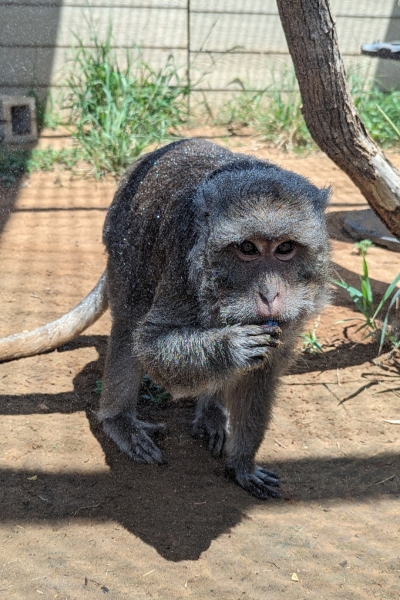Keeping cool in the South Texas heat is very important for monkeys and humans alike. Summer temperatures in our area average around 98°F, with highs of well over 100°F in late July and August. The various species we care for at the Born Free USA Primate Sanctuary have different heat tolerances, with Japanese and bonnet macaques at the low end and baboons and rhesus macaques at the high end. Most of the species we care for live in climates that fall in the 70° – 80°F range in the wild, so when things heat up, they need a way to cool off.
Appreciating Individual Heat Tolerance Differences
Apart from species-specific heat tolerance differences, individuals within species have their own preferences based on their background, health, and personality. Just like humans, some monkeys do worse in the heat than others. Monkeys raised as “pets” or in labs are worse off than their wild cohorts, because they may not have learned proper thermoregulation techniques in their youths. Sometimes monkeys who come to us have lived their whole lives in air conditioning and must quickly adapt to the outdoors. We also have elderly individuals, those with health problems, and those on medication that cause them to require more water than normal. We always need to keep a close eye out for signs of dehydration, because in these temperatures, not drinking enough water can quickly lead to trouble.
Our Tools for Helping the Monkeys Beat the Heat
There are a few tools in our arsenal for beating the heat: pools, misters, ice treats, and shade. Pools and troughs are useful for letting the monkeys submerge their whole body in water. Many species of macaque swim in the wild, so giving them pools or even large ponds allows them to engage in natural behaviors. Japanese and long-tailed macaques are the biggest fans of this heat fighting method. You can often see some of the younger Japanese macaques leaping from a tree into a pool with a giant splash.
We make misters by screwing misting nozzles into PVC pipes, which we attach to hoses controlled by timers. During the heat of the day, misters will alternately turn on and off, cooling the air and hot surfaces. Many of the monkeys enjoy sitting directly under the misters until their fur is so sparkly with water droplets that they look like they’re covered in diamonds.

Ice enrichment is always a favorite in the hot months. We can give the monkeys frozen fruit, or make “popsicles” with nuts and other yummy treats frozen in flavored water. Some of the monkeys, like Kaleb the baboon, enjoy munching on plain ice cubes.
Finally, a very important method of keeping cool is utilizing shade. It can be up to 10 degrees cooler in the shade than in the direct sun, so we make sure that the monkeys always have access to areas where they can find cover. Nest boxes, shade sails, or cinderblock houses are all good ways to create shade and cool the monkeys down. They also use the trees growing in their enclosures; whereas in cool temperatures they climb to the very tops, in the summer they sit underneath.
Help the Monkeys Stay Cool
The summer can be brutal, but caregivers work hard to make sure that the monkeys always have a way to stay cool! You can help keep the monkeys beat the heat, too! Donate to our Keep the Monkeys Cool fundraiser to equip caregivers at our sanctuary with all the tools they need to help keep 200+ monkeys cool and safe in the south Texas heat.
A donation of $10 gets popsicles for the monkeys, $15 can get them a sprinkler, and $25 can give them a kiddie pool! Learn more about how you can help keep the monkeys cool all summer long!
Keep Wildlife in the Wild,
Katie
Dear Reader,
We are a nonprofit committed to wildlife conservation, welfare, and rescue. Making resources free and widely distributed, like our news items, is an important part of our mission. If you found this article helpful, enjoyable, or enlightening, please donate to help keep these resources available, and Keep Wildlife In The Wild.
Thank You,
The Born Free USA Team
